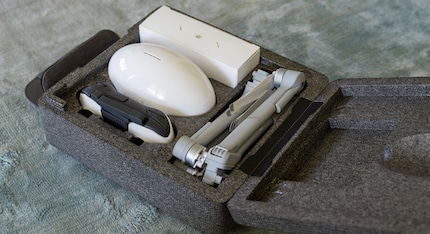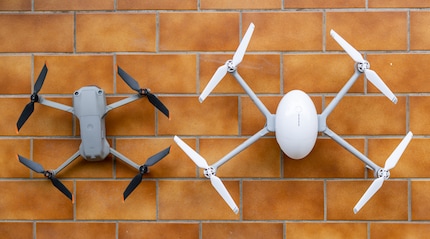

Review: PowerEgg X, the oval allrounder
The PowerEgg X drone is waterproof, records videos with sound and can be used as a camcorder. It also looks extravagant. Sounds great, but it’s not.
Drones are normally afraid of water. That’s where PowerVision’s egg-shaped device is different. You can put it in waterproof housing and fly it in therain. You can also add floats that enable the drone to land on and take off from water.
As if that wasn’t special enough, the PowerEgg X can also be used as a camcorder.

Using it for the first time
The drone comes in a practical little case that protects it well from any knocks and blows. The water resistance kit, which consists of waterproof housing and two floats, comes in a separate package that’s not suitable for transport. If you put the drone in the casing, it won’t fit in the travel case. In other words, there’s no space-saving way to transport the drone.

I first have to set up the drone. That’s when the Kinder egg delivered its first surprise. The battery won’t charge up and is suspiciously curved. In other words, it’s broken. Fortunately, the water resistance kit includes a spare battery – otherwise that would’ve been the end of this review.
The dedicated app, «Vision+ 2», runs on iOS 10 or Android 5, which makes it compatible with almost any smartphone. I’m using an iPhone 12 mini. The cables you need are also included: lightning, USB-C and micro USB. The charger can power the drone battery, remote control and your smartphone at the same time.
But first, the drone has to be connected to the app. It doesn’t work initially. And it doesn’t work later either. I tried both the QR code and inputting the code manually. It was only when I had the idea to connect the drone to the Wi-Fi manually rather than via the app that I got it to work.
Then all I had to do was insert the microSD card and it was ready to go. At least that’s what I thought. The thing is, the card slot is under the battery – like the SIM card in old Nokia phones. So that required taking the battery out, putting the card in and replacing the battery again. Then the app told me I should remove the SD card; otherwise the firmware update couldn’t be installed. Here we go again: battery out, card out, battery in, install firmware, battery out, card in, battery in. Incidentally, I can’t put the battery straight in as there’s still a protective cover over it.
When I finally manage to do a test recording, I’m disappointed. The image quality isn’t particularly good, and the sound quality is subpar. The drone has a loud built-in C fan, which also runs constantly in Camcorder mode. That’s why it sounds like you filmed the recordings in an engine room.
You can use a strap to hold the egg like it’s a camcorder. The camera is dubbed «intelligent» by the manufacturer, as it can follow objects and stabilise stepping movements with the help of its own gimbal. There are three gimbal modes: FPV, Follow and Lock. It looks good and all, but as the recording quality is worse than on your average five-year-old smartphone, I don’t see the point in doing a deep dive review of it.
The first flight
The drone is quite big – much bigger than a DJI Air – and it has a nice engine noise that’s not too loud. The controls and app use a similar concept to the type you might recognise from DJI hobby drones.

But the tracking features are noticeably worse. Object tracking can only start from a height of at least four metres. Orbiting a Point of Interest (POI) is also complicated. First, you have to fly right over the object you want to select and then put the drone in the starting position. Once you’ve begun the process, you have to stop at the crosshairs; otherwise the drone won’t keep the object in the middle.
I don’t discover the worst bit until afterwards. When you’re recording videos, the image keeps freezing. And I don’t just mean the live image. It also freezes on the recording, which the drone saves directly to the SD card.
When the drone was flying, I realised that the sound isn’t recorded by the drone itself but by the smartphone. As soon as the drone is far away, the engine noise disappears. This also lets you stop it whirring in Camcorder mode. However, in a lot of situations, it simply doesn’t make sense to record the sound and image in completely different places. Moreover, the audio quality is drastically compromised and a lot worse than is customary on a smartphone. That’s probably because the sound is synchronised with the image – which works well all the same.
With the automatic return home feature, the drone lands in tall grass and acts as a lawnmower. From now on, I’ll land manually. My audible scolding in the video is down to the fact I can’t stop the recording once the drone has landed.
In the rain
The waterproof housing can be used with or without floats. You have to choose the mode in the app before you get started. I test it out initially without any floats.
The PowerEgg X flies in the rain without any problem. But drops of water roll down the casing and cloud the recording. Besides, the scenery doesn’t look particularly enchanting in wet weather. I think to myself: yeah, sure, you can film in the rain – but what’s the point?
The remote control probably isn’t waterproof, and most smartphones aren’t either. So, you’d have to be flying the drone under shelter, which isn’t always possible. And it goes against the requirement of having to see it while it’s in the air. You also have to attach the casing in a dry environment; otherwise you’ll get rain on the parts that are sensitive to water. However, there’s the issue that the drone needs a lot of space once the casing is on, making it impractical to transport.
If you try to land the drone on water without the floats, you run the risk of it going under water for a brief moment. But it overcomes this easily before carrying on with its flight.
However, the drone regularly struggles to stay stable in the air. It drifts off to the side or changes height. One time, this lead to a small crash. But given the drone is water-resistant, it managed to withstand it without any damage.
On the lake
Water landings sound funny. But there aren’t a lot of realistic possible uses for the drone. Things can easily go wrong if you use it on rivers with a strong current. Sedate streams are often under trees where GPS doesn’t work. Meanwhile, a lot of lakes are in nature reserves where drones aren’t allowed. And there’s no way you can have a drone whirling around people in an outdoor pool.
That’s why I decide to go to Lake Walen. You’re allowed to fly drones there, and the surroundings look good. Attaching the styrofoam floats is quick, and you don’t need any tools. But then the drone wouldn’t start. The GPS couldn’t find enough satellites.
The steep mountains of Lake Walen probably block out part of the GPS satellites. I unpack the DJI Mavic Air 2S to get a comparison. The app also shows me that the GPS signal is weak, but the drone still flies without any problems. When it comes to the PowerEgg, there’s no chance of getting it to fly.
At some point, after shifting the starting point many times, the drone took off. Unfortunately, some of the battery is already used up. And the floats shorten the flight time as the air resistance is greater. But I still have the chance to take it on a few laps and get it to land on the water. It works.
In nice weather, the sunlight reflects off of the casing. Drops of water magnify the effect. But it also happens when the casing is completely dry.
During this trip, two things broke. There are two small glued-on rubber mountings within the casing. And one of them came off. Maybe my inexperienced handling played a part in that, but they weren’t particularly stable to begin with.
Also, the smartphone mount on the remote broke. How did it happen? The image was always upside down, except when I placed the smartphone perpendicularly. That meant I always wanted to move the phone further, even though the hinge was already at breaking point. And as the hinge is strong, you don’t notice that you’ve already reached that point.
Verdict: trying too hard
I like the originality of the PowerEgg X, and the concept works well in principle. There are no issues with landing on and taking off from water or flying in the rain. If you absolutely need it for a project, there just aren’t any alternatives.
But if there were, I wouldn’t recommend the PowerEgg X. The thing has too many flaws. The already meagre image quality is impaired even more by drops of water and reflections. There’s also the issue of lag on video recordings. In Camcorder mode, the fan noise and the poor audio quality are too disruptive in general. The GPS signal is so weak that it can’t always be used to its full extent in the open air. Meanwhile, flight characteristics, flight aids and obstacle detection on the PowerEgg X aren’t on a par with the DJI. The battery was already beyond repair straight out of the factory, and many things broke when they were used. Even the software didn’t run defect-free. PowerVision wants to do too much at once with this egg. All things considered, PowerEgg X is a device that can do a bit of everything, but it can’t do any of it well.
My interest in IT and writing landed me in tech journalism early on (2000). I want to know how we can use technology without being used. Outside of the office, I’m a keen musician who makes up for lacking talent with excessive enthusiasm.


